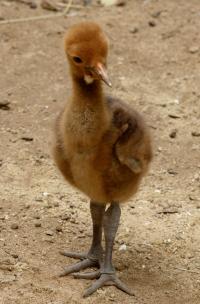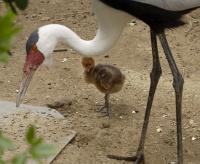
This rare wattled crane chick hatched at the Smithsonian's National Zoo on March 30. The chick is the National Zoo's first in its 118-year history. Visitors can see the wattled crane chick and its parents at the Zoo's Bird House outdoor exhibit. There are 63 wattled cranes in the North America zoo population and an estimated 8,000 in the wild. Adult wattled cranes stand 6 feet tall and weigh approximately 14 pounds. Credit: Jessie Cohen/Smithsonian's National Zoo Smithsonian's National Zoo has announced a first in its 118-year history -- the hatching of a rare wattled crane chick.
After 33 days of incubation by the adult pair of wattled cranes, the egg hatched March 30. Staff had not checked the egg during the incubation period in an effort to not disturb the parents and were delighted when the healthy chick emerged.
"This is a great milestone for the Smithsonian's National Zoo and for this species," says Paul Tomassoni, the Zoo's curator of birds. Destruction of its native wetland habitat in south-central Africa has dramatically decreased wattled crane populations in the wild, and breeding programs like the National Zoo's have helped to stabilize this species' future. 
This rare wattled crane chick hatched at the Smithsonian's National Zoo on March 30. The chick is the National Zoo's first in its 118-year history. Visitors can see the wattled crane chick and its parents at the Zoo's Bird House outdoor exhibit. There are 63 wattled cranes in the North America zoo population and an estimated 8,000 in the wild. Adult wattled cranes stand 6 feet tall and weigh approximately 14 pounds. Credit: Jessie Cohen/Smithsonian's National Zoo
The value of this new chick at the National Zoo also is reflected in its genes. The pairing of its parents was recommended through the Wattled Crane Species Survival Program. An SSP is a breeding program among American accredited organizations that ensures the creation and maintenance of a healthy and self-sustaining population that is both genetically diverse and demographically stable.
The wattled crane chick's gender is unknown, and staff are awaiting the results of blood tests for the answer. The Zoo waited to announce the hatching until it was determined that both of its first-time parents would be able to care for it properly. The chick and its parents may be seen in their outdoor exhibit at the Zoo's Bird House along side the Zoo's three other species of crane.
There are 63 wattled cranes in the North America zoo population and an estimated 8,000 in the wild. Adult wattled cranes stand 6 feet tall and weigh approximately 14 pounds. In the wild, their primary diet consists of aquatic plants and insects. Wattled cranes are listed as "vulnerable" by The World Conservation Union.
Source : Smithsonian
 Print Article
Print Article Mail to a Friend
Mail to a Friend
